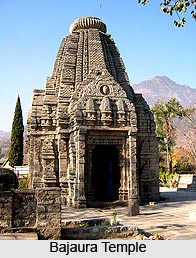 Bajaura Temple is an ancient shrine nestled in the Himachal Pradesh state of India. It is also called as `Basheshwar Mahadev Temple` and `Visveshvara Mahadev Temple`. This pyramid-structured temple is positioned on the banks of the Beas River. Among all the stone-temples in Kullu, Bajaura temple is the largest one. It is famous across northern India for its central shrine dedicated to Lord Shiva. It is also notable for its flat shikhara, amazing stone carvings and elegant sculpted figures. The temple attracts devotees from across the world.
Bajaura Temple is an ancient shrine nestled in the Himachal Pradesh state of India. It is also called as `Basheshwar Mahadev Temple` and `Visveshvara Mahadev Temple`. This pyramid-structured temple is positioned on the banks of the Beas River. Among all the stone-temples in Kullu, Bajaura temple is the largest one. It is famous across northern India for its central shrine dedicated to Lord Shiva. It is also notable for its flat shikhara, amazing stone carvings and elegant sculpted figures. The temple attracts devotees from across the world.
Location of Bajaura Temple
It is located about 200 metres off the Kullu-Mandi road in Hatta, Himachal Pradesh. It is situated at Bajaura on National Highway 21. The temple is 15km away from Kullu town and about four kms from Bhuntar Airport.
Attractions of Bajaura Temple
This ancient temple is known for its fine architecture. According to the book `Himalayan Art`, written by Mandanjeet Singh, an Indian art historian, the temple was built in the eleventh century. However, some historians say that it was built in 8th century. The temple looks a bit squat with an unusually flat Shikhara. The outer surface of the temple is adorned with intricate stone carvings. The three sides of the temple exhibit amazing carvings of gods. The bulging tower of the temple also features some intricate carvings that speak in volume about the architect of ancient era. The controlling deity of the temple is Lord Shiva. Bajaura Temple enshrines a large `yoni-lingam` and the outer sides of the shrine are decorated with the images of Goddess Durga, Lord Vishnu and Lord Ganesha.
Connectivity of Bajaura Temple
The nearest airport is Chandigarh airport which is well connected to Delhi, Shimla and Chandigarh. It is the largest airport in this region and is linked with Bhuntar and Kullu with regular bus services and private taxies. The closest railheads are located at Pathankot, Jogindernagar, Shimla, Kalka and Chandigarh. From these railway stations, tourists and devotees can easily avail bus or taxi services to reach the temple. The best time to visit the temple and explore the beauty of the place is during October and between June-September.





















